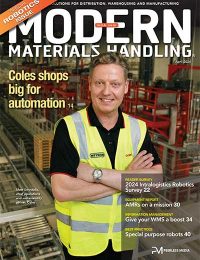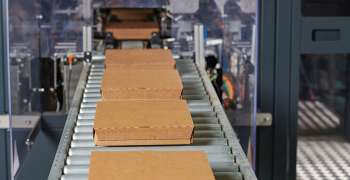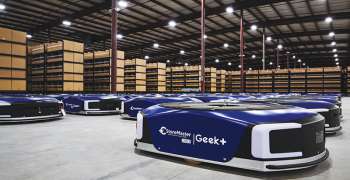2014 Warehouse/DC Equipment Study: Maxed out
Our annual look into spending plans inside the four walls highlights growing interest in automation and software as workforce issues factor heavily into equipment investments.
Latest Material Handling News
Over the last few years, the results of Peerless Research Group’s (PRG) State of Warehouse/DC Equipment and Technology Survey have reflected an industry scrambling to adjust.
The recession, the e-commerce boom, and advances in materials handling equipment and software have rewritten the rules on what seems like an annual basis. Just since 2010, the average anticipated spending on such equipment has spiked by 15 percent or fallen by 26 percent from one year to the next.
Whatever survey respondents are doing with their money, it seems to be working. Activity levels as a percentage of capacity are at their highest since at least 2007, while 95 percent of respondents believe that their activity levels will increase (by an average of more than 20 percent) or stay the same in the next two years.
Yet even as the number of potential investors taking a “wait and see” approach declines from 50 percent to 43 percent and the number “proceeding with investments” jumps from 19 percent to 27 percent, spending figures have been trending downward. Having spent heavily to set the aircraft carrier in the right direction, the industry is transitioning to targeted investments aimed at keeping the ship on course.
Continued interest in automation
We know activity levels have grown in manufacturing (75 percent, up from 63 percent in 2012), warehousing supporting manufacturing (69 percent, up from 56 percent in 2011), and standalone warehousing (68 percent, up from 60 percent in 2011).

That growth is largely due to a focus on doing more with less—optimizing existing facilities instead of new building. Technology and equipment investments have already helped support data-driven improvements, but many respondents feel there is much more to be done.
“Technology is expected to become even more critical in the upcoming years as a growing percentage of operations plan to automate inventory control and handling, distribution processes, and labor management,” says Judd Aschenbrand, director of research for PRG. “In warehouses and DCs, continuous improvement, workload planning, and lean processes are key initiatives going forward.”
The survey results point to significantly increased interest in automated processes in the next two years. There are sizable gaps between the number of respondents currently using automation to evaluate productivity in various functions and those who expect they will have transitioned to automated approaches within the next two years.
Those soon-to-be-automated functions include the tracking of inventory levels (58 percent currently automated, 76 percent in two years), order fulfillment costs (40 percent, 60 percent in two years), and daily throughput (44 percent, 69 percent in two years).
This is reflected in the increased percentage (54 percent, up from 50 percent) of respondents who plan to invest in information technology hardware or software in the next 12 months. But respondents are also keen to optimize the productivity of each and every worker, anticipating growth in automated tracking of picking accuracy (33 percent currently automated, 62 percent in two years) labor hours (51 percent, 69 percent in two years) and on-the-job injuries (18 percent, 37 percent in two years).
Investing to curb workforce challenges
The growth of multi-channel distribution and e-commerce have pressured the distribution center and supply chain to run ever more efficiently, according to Norm Saenz, managing director at supply chain consultancy St. Onge Company.

“In an effort to cut operating costs, some might have performed layoffs in recent years,” Saenz says. “Now that activity levels are up, the back is breaking in many facilities, and thus the willingness to spend on automation to enhance the productivity of those workers. But while technology and automation receive the headlines for improvement in operations, more businesses understand it’s the labor force that sustains productivity and high service levels.”
When asked to identify the issues that are most relevant now and to estimate their relevance in two years, 89 percent of respondents again placed safety at the top of the list. Just two years ago, cost containment topped the list, but it now sits in second place with 76 percent. Labor-related issues like training (63 percent), labor availability (52 percent) and ergonomics (48 percent) are expected to become more pressing in coming years.
“The sophistication of the skill sets required to operate leading-edge equipment and system solutions in the material handling, logistics, and supply chain industry will require an equally sophisticated and well-trained workforce,” says George Prest, CEO of supply chain association MHI. “Hiring, training, and retention of workers is the most important issue facing this industry.”
But none of the listed issues saw a greater jump in anticipated relevance than environmental sustainability. Currently, 40 percent of respondents see it as an important issue, and 51 percent believe it will be within two years.
“Because they are elective and not mission-critical, green initiatives go hand in hand with how well the global economy and the individual company are doing,” says Aschenbrand.
Supply chain visibility
In a new question added to the survey this year, respondents were asked about the level of end-to-end visibility across their supply chains.
An impressive 36 percent indicated that they have full end-to-end visibility across their supply chains, while another 27 percent described their manufacturing and warehousing operations as a group of discrete silos. In the middle, 61 percent stated they are in the process of improving integration among supply chain nodes. “End-to-end supply chain visibility will be a requirement for future supply chains,” says Prest.

For example, the multi-channel model requires it, says Prest. “While many companies have traditionally maintained dedicated facilities to serve demand from specific channels, companies adopting multi-channel strategies must maintain real-time visibility of inventory at different facilities and synchronize operations across the supply chain,” he says. “This visibility will improve efficiencies by maintaining one common pool of inventory.”
Cloud-based or software as a service (SaaS) approaches are gaining some ground in this space, although overall adoption remains modest. Only about a third have either adopted (13 percent) or are currently evaluating (18 percent) SaaS or cloud computing strategies. Twenty percent have determined “it’s not for us,” 36 percent aren’t sure of their company’s interest, and 10 percent are not sure what cloud computing is.
“Those who are adopting these strategies cite cost savings, data reliability across the enterprise, streamlining of operations, ease of information access, and improved communications with customers and suppliers,” says Aschenbrand. “But concerns over security, privacy, data integrity and system reliability remain as reasons for non-adoption.”
Software: Cornerstone for improvement
In the next 12 months, 43 percent of planned spending will go toward materials handling equipment like racks and shelving (49 percent), lift trucks and accessories (47 percent), bar coding (33 percent), conveyors and sortation (26 percent), mobile and wireless solutions (24 percent), and robotics and automation (16 percent).

In past years, investment in equipment might have been independent from investment in information technology solutions, but Saenz says that’s no longer the case.
“There is a close relationship between equipment and IT investments,” says Saenz. “At some point, when automation is included in the investment, certain software and handling control systems are required to efficiently manage the automation. Generally, as the investment in equipment and IT increases, the relationship becomes much closer between the two.”
Planned spending on information technology suggests businesses will work to improve the collection and management of data from every corner of the supply chain. In the next year, roughly a quarter of respondents will invest in each of the following: enterprise resource planning (ERP), warehouse management systems (WMS), warehouse control systems (WCS), and asset management systems. Labor management systems (15 percent), and voice recognition technologies (15 percent) also placed high on the list.
“WMS has evolved into a sophisticated $1 billion-plus industry that operates in a highly competitive environment,” says Prest. “The top providers have expanded their solution offering beyond the warehouse and the term ‘supply chain execution’ has been widely adopted to reflect the shift to more comprehensive logistics applications. Thus the WMS category for this type of solution may be too limiting.”
For companies not yet ready to shed their legacy WMS, Saenz says that many can enjoy strong returns from bolt-on modules. “At a fraction of the investment, an LMS can greatly improve the control and productivity of the labor force, and stronger inventory management module can be a significant cost savings opportunity,” he says. “This could be a ‘Band-Aid’ approach to enhancing their systems, should the company replace the entire WMS in the future.”
As they move forward with information technology initiatives, 61 percent of companies prefer to work with a suite of applications from a single vendor, as opposed to the 39 percent who prefer a best-of-breed strategy employing software from various suppliers.
Once businesses have established a solid baseline of internal data, they will expect trading partners to be able to share comparable information. Today, 24 percent see trading partner collaboration as an important issue, and 30 percent expect it to be more important in the next two years.

Article Topics
Magazine Archive News & Resources
Latest in Materials Handling
Beckhoff USA opens new office in Austin, Texas Manhattan Associates selects TeamViewer as partner for warehouse vision picking ASME Foundation wins grant for technical workforce development The (Not So) Secret Weapons: How Key Cabinets and Asset Management Lockers Are Changing Supply Chain Operations MODEX C-Suite Interview with Harold Vanasse: The perfect blend of automation and sustainability Consultant and industry leader John M. Hill passes on at age 86 Registration open for Pack Expo International 2024 More Materials HandlingAbout the Author
Subscribe to Materials Handling Magazine

Find out what the world's most innovative companies are doing to improve productivity in their plants and distribution centers.
Start your FREE subscription today.
April 2024 Modern Materials Handling

Latest Resources










